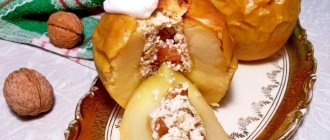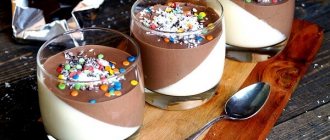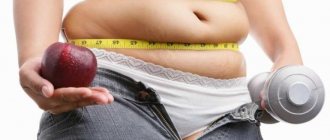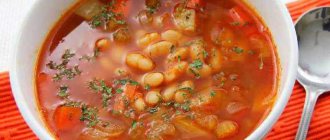The law obliges food manufacturers to indicate their composition on the label. The modern buyer is increasingly paying attention to this list. The most questions arise for substances designated by numbers under the letter “ E ”. These are nutritional supplements designed for various purposes. Some of them are included in the product to give it a sweet taste. Such components are united by a common name - “sweeteners”. What is the reason for the appearance of these compounds in many food products, what benefits or harm can they cause to health, how do they differ from traditional sugar. This article answers these questions.
What is a sweetener?
If you choose to read several articles from the first list on the Internet for the query “sweeteners,” then the confusion in definitions immediately catches your eye. It arises when trying to classify and divide sugar substitutes into sweeteners and sugar substitutes. The criteria for differences are: energy value, origin (natural or artificial), chemical composition and others. Cases when the same drug is included, for example, in the table of intense sweeteners, and a few lines below is mentioned as a sweetener, are found everywhere.
Let's take this definition as a basis. Sweeteners are substances of natural origin or artificially synthesized that have a sweet taste. Preparations of this group are distinguished by their non-sugar nature, that is, they lack a glucose group. This determines the nature of its effect on the human body, which is different from that of sugar. In the medical environment, it is customary to further divide sweeteners into 2 groups based on energy value, into high-calorie and low-calorie substances. The sources of sweet taste in sugar substitutes are carbohydrates, polyhydric alcohols and proteins.
Aspartame E951
It is difficult to find a more studied nutritional supplement than aspartame. It's a shame that so many resources are spent on studying the simplest safe molecule aspartame, instead of solving truly important health problems.
3D model of aspartame molecule and molecular formula.
E951 is a synthetic non-caloric sweetener that is 180 times sweeter than sugar. This sweetness is due to the ability of substance molecules to linger on the taste bud. In the book “Sweetness and Sweeteners. Biology, Chemistry, and Psychophysics" describes in detail the mechanisms of sweet taste sensation and its genetic components. I added the book to the file with additional links.
Properties
- Chemical formula C14H18N2O5
- Molecular weight 294.31 g/mol.
- The sweet taste develops slightly more slowly than sucrose, but forms a stronger bond with the receptor. This is due to the aftertaste of most sweeteners - it is more difficult for saliva to wash away their molecules from the receptor.
- Does not cause thirst. Thirst from drinks with sugar substitutes is another very common myth.
- Does not increase appetite or glucose levels (7, 8, 9, 10).
- Does not affect intestinal microflora.
- It loses its sweetness when heated for a long time, so it is not suitable for baking or boiling.
From the discovery of aspartame's sweet taste in 1965 to today, more than 50 years and more than 700 studies have passed on bacteria, animals, healthy people, diabetics, nursing mothers and even babies (1).
The question arises: if its safety has been proven, why so many controversies and “exposing” programs on TV? Apparently, the problem is in the metabolites: methanol, formaldehyde and aspartic acid. Let's sort this out once and for all.
Effect on the body
E951 cannot be detected in the blood, even when exceeding the recommended daily dosage several times. In our stomach, the sweetener breaks down into three lighter molecules:
- Phenylalanine 50%
- Aspartic acid 40%
- Methanol 10%
The content of harmful compounds in familiar products is several times higher than in a sugar substitute.
These substances are absolutely normal components of the diet and are even produced by our body.
Content of phenylalanine and aspartic acid in food (USDA data)
| Source | Phenylalanine content (g/100 g food) | Aspartic acid content (g/100 g food) |
| Soya beans | 1,91 | 4,59 |
| Peas | 1,39 | 2,88 |
| Lentils raw | 1,38 | 3,1 |
| Peanuts all types | 1,34 | 3,15 |
| Chickpeas and beans | 1,03 | 2,27 |
| Flax seeds | 0,96 | 2,05 |
| Pork, salami | 0,94 | 2,1 |
| Beef | 0,87 | 2 |
| Chicken, fish | 0,78 | 1,75 |
| Whole eggs | 0,68 | 1,33 |
| Whole milk | 0,15 | 0 |
The most popular artificial sweetener. It is 150-200 times sweeter than sugar. As a sweetener it is included in more than 6,000 products, including
children's vitamins, medicines, diet drinks. It is added to many public catering dishes.
Aspartame does not stimulate the release of insulin from the beta cells of the pancreas. It can be used by overweight people, pregnant women, nursing mothers, and children. Contraindicated in persons with phenylketonuria, a rare hereditary pathology (therefore, in many countries, including Russia, products containing aspartame must have the warning “Contains a source of phenylalanine”). Aspartame is used in more than 100 countries around the world.
Advantages
- In the body, aspartame is broken down into simple elements - amino acids, which are organically included in metabolism. - Its presence enhances the taste and aroma of fruits.
Flaws
– Thermally unstable, begins to decompose at 80°C, when heated, it loses its sweet taste, therefore it is not suitable for sweetening foods subject to heat treatment.
– Loses sweetness in an acidic environment (for example, in tea with lemon) and in an alkaline environment.
The recommended safe daily dose of aspartame is no more than 300 mg. This is approximately 15 tablets (one tablet contains 18 mg of aspartame).
What is the reason for the popularity of sweeteners?
Even preschoolers know about the dangers of excessive sugar consumption. However, there is a paradox - despite widespread awareness of the negative consequences, its consumption is constantly growing. People like sweets; they lift their spirits and provide a pleasant taste experience. Scientists talk about the addictive effect of sugar, which is similar to drug addiction. In addition to ordinary household use, there is also hidden consumption. Sugar is present in foods that cannot be called sweet. For example, a kilogram of regular sausages contains 90 g. Mass obesity, heart and stomach disorders, tooth decay, a sharp surge in the incidence of diabetes - this is the price to pay for sugar abundance.
Did you know that...?
According to statistics, the average Englishman consumes 238 teaspoons of sugar per week. As a result, a quarter of UK residents are obese. Residents of Foggy Albion spend 5.1 billion euros a year on the treatment of diseases caused by excess weight.
Even partial replacement of sugar with sweeteners significantly reduces the calorie content of the usual diet, lowers blood glucose levels, which helps normalize weight. At the same time, people do not feel taste discomfort. Sugar substitutes completely compensate for the sweetness of products, often unnoticed by the consumer. According to some medical scientists, a 40 percent switch to sweeteners can eliminate the problem of excess weight in most people and halve the likelihood of diabetes.
Sweeteners are in demand by the food industry and are beneficial to use. Most sweeteners are tens or even hundreds of times sweeter than sugar, meaning smaller doses of drugs are required for production. Thanks to this, warehouse space is freed up, less money is spent on transportation, and by reducing the weight of the additive, the yield of the main product increases.
Fructose (fruit sugar, levulose)
It is obtained from fruits and berries. Natural fructose is contained in honey (almost half of the total weight). Outwardly, it looks almost the same as sugar, but at the same time it is 1.2-1.8 times sweeter. The main advantage of fructose is that, unlike glucose, it increases blood sugar levels three times slower.
Fructose has approximately the same energy value as sugar (375 kcal per 100 g of weight), it is absorbed from the gastrointestinal tract more slowly than glucose, but is absorbed more quickly by the body's cells, mainly by liver cells with the formation of glycogen. Due to this, it has little effect on insulin secretion.
According to many nutritionists, replacing sugar with fructose is the prevention of diabetes.
Advantages
– The taste is not inferior to sugar.- In any dish, it emphasizes the taste and aroma of fruit.- It is used in the preparation of not only drinks (tea or coffee), but also compotes, jams and preserves.- Products with fructose retain freshness longer.- Replacement of sugar with fructose reduces the risk of diabetes and caries.
Studies have shown that fructose is more effective than sugar, restores strength and has a certain tonic effect - increases performance, mood and overall tone. In this regard, eating fructose instead of regular sugar is most useful primarily for weakened people, athletes during intense training, elderly people, anyone engaged in heavy physical labor, etc.
Flaws
– Patients with diabetes need to remember that fructose, although to a lesser extent than sugar, affects blood sugar levels and can contribute to the occurrence of acidosis - a shift in the blood reaction to the acidic side, and therefore it must be used very carefully in diabetes.
– Those who want to lose weight should not forget that fructose is not much inferior in calorie content to ordinary sugar. The recommended daily dose of fructose is no more than 45 g.
Benefits of using sweeteners and sweeteners
The benefits of sugar substitutes can be divided into two groups.
Economic and production:
- significant reduction in production costs;
- reducing the number of technological operations in production;
- enhancement of taste, its enrichment by a combination of sweetener with acids and flavors;
- freeing up warehouse space, reducing transport load;
- Products with added sweeteners are stored longer than the same products with sugar.
Consumer:
- Reducing caloric intake, which helps maintain normal weight;
- Reducing the risk of tooth enamel destruction; some sweeteners, on the contrary, strengthen it;
- Natural sweetener, made from plant materials, serves as an additional source of vitamins and minerals;
- There is an improvement in the functioning of the immune system, blood pressure normalizes;
- Certain sweeteners, such as stevia, remove “bad” cholesterol from the body.
It is impossible not to note the huge role that sugar substitutes play in the daily life of diabetics. Sugar substitutes are a real godsend for these people. They are forced to follow a strict carbohydrate diet, which is aggravated by a complete ban on the consumption of sugar in all forms. Artificial low-calorie sweeteners restore sweet taste to patients. These substances do not increase blood glucose levels because they do not contain it. Nowadays, a wide range of confectionery products, baked goods, sweet mixtures, and drinks with sweeteners instead of sugar are produced for diabetics.
Our company offers chocolate bars with stevia (Fig. 1) at a price of 229 rubles. for 1 piece and a chocolate drink with stevia (120 g of powder in a plastic jar, price for 1 piece - 910.10 rubles). One spoon is enough to get a glass of a delicious drink. Products specifically for diabetics. Delivery in Moscow within 24 hours.
Saccharin E954
The world's first safe sweetener, which has experienced countless ups and downs. The history of saccharin, 120 years long, cannot be described in a few words - it resembles a world-scale spy detective story with Roosevelt, Churchill and Swiss customs in the leading roles (19).
Additive E954 got more than aspartame and cyclamate combined. At the end of this section, I will focus on the most sensational study, the methodology of which caused a stir in the scientific community and almost buried the first safe sweetener.
Properties
- Chemical formula: C7H5NO3S
- Molecular weight: 183.18 g/mol
- Crystalline powder, odorless.
- It has a metallic taste and bitterness in high concentrations, but when mixed with cyclamate it gives a sugary sweetness.
- Does not deteriorate for decades.
- Sweeter than sucrose from 300 to 550 times (depending on the production method).
- Fixes and enhances the aroma of products.
- Retains properties in baking.
Effect on the body
Saccharin is not digested and is quickly excreted unchanged in the urine (20). Long-term effects were tested on several generations of different laboratory animals. The results indicate no effect on DNA (21).
Back in the early 20th century, there were concerns that saccharin could be metabolized into sulfamoylbenzoic acid, but laboratory methods have not confirmed this (22). Test-tube studies make it possible to achieve hydrolysis of the sweetener into sulfamoylbenzoic acid at a solution pH of no higher than 5 and only after 48 hours of saccharin being in the solution (no one can hold urine for that long, and pH 5 is far from the norm).
Synthesis of saccharin according to one of numerous patents. It has not been produced from coal for about 80 years.
In rats given 50 mg of saccharin daily for a year, 96% of the substance was eliminated within 7 days, after which each organ was tested for remaining radioactive molecules. Individuals that were adequately fed for life recovered 96–100% in urine and feces within 24–72 hours (23).
Problems with the elimination of the E954 sweetener were observed in laboratory rabbits who were given 5 grams of the substance once, with a daily maximum of 5 mg/kg body weight. After 72 hours, the rabbits were dissected and saccharin was found unchanged in the digestive organs of the animals.
Diet drinks from the 50s with cyclamate and saccharin
Epidemiological studies of bladder cancer in humans among 40,000 cases of cancer of various etiologies found no association between this disease and the use of sugar substitutes. The groups included diabetics who had been consuming the sweetener for decades.
Let me return to the experiments on rats that could have ended the saccharine era. The situation is exactly the same as the “cancer” study of cyclamate. In March 1977, Canadian scientists succeeded in causing bladder cancer in rats.
A schedule was immediately drawn up for the gradual ban of the substance in Canada, despite the fact that preliminary results were widely considered premature. In the USA they tried to do the same thing, citing the amendment. The American Cancer Society and the Diabetes Association discouraged this without reproducing the study themselves because the Canadian methods were appalling.
Its sweetness (per unit weight), according to various authors, is 300-400 times higher than that of sugar. That is, instead of 2 teaspoons of sugar, it is enough to put a tiny tablet containing 16 mg of saccharin in tea.
Advantages
– Retains sweetness in the presence of acids. – Stable when frozen and heated, therefore suitable for preparing any culinary dishes, including baking.
Flaws
– It has an unpleasant metallic taste (that’s why cyclamate is added to modern sweeteners based on saccharin to improve the taste).
– Prohibited during pregnancy (although there is no reliably confirmed data on its penetration through the placenta).
– Suspicions about the danger of exacerbation of cholelithiasis associated with saccharin have not yet been completely eliminated.
– Banned in the USA, Canada and EU countries, as it is considered a potential carcinogen.
– Experiments on mice showed that large doses of saccharin cause bladder cancer (however, subsequent studies did not confirm this fact).
For a person of average weight (70 kg}, it is recommended to consume no more than 10-12 tablets of saccharin per day (one tablet contains 16 mg of saccharin).
Harm from sweeteners, possible negative consequences of taking them
- Most natural sweeteners do not match the “pure” sugar taste. Some have a “metallic” taste, others are bitter. It should be noted that the extracts of these substances are completely free from this disadvantage.
- Significant excess of a single dosage of natural preparations causes nausea, stomach and intestinal upset, and diarrhea.
- Artificial sweeteners have the most problems. In Europe, the USA and a number of other countries there is a ban or restriction on the use of some of them. Thus, aspartame decomposes at temperatures above 300 C, releasing a certain amount of formaldehyde; its use is strictly regulated; cyclamate is banned in France, the UK and the USA because it is suspected of causing kidney failure; Cesulfame is banned in Canada and Japan and is believed to cause allergies.
It should be taken into account that a serious struggle has unfolded in the world between sugar producers, on the one hand, and companies producing sugar substitutes, on the other hand. Any methods are used, provocative “stuffing” of supposedly reliable information is carried out, public and medical organizations are inclined to their side. As a clear example, we can cite the history of recognition of the safety of stevia (Fig. 2). At first, this plant was accused of being mutagenic and carcinogenic. Only thorough research conducted by the World Health Organization completely “rehabilitated” stevia honey. (https://ru.wikipedia.org/wiki/%D0%A1%D1%82%D0%B5%D0%B2%D0%B8%D1%8F_%D0%BC%D0%B5%D0%B4% D0%BE%D0%B2%D0%B0%D1%8F).
Did you know that...?
As soon as the time to harvest sugar beets or sugar cane approaches, the number of articles on the dangers of sugar substitutes sharply increases in the world media. And publications about the negative role of sugar are practically disappearing.
How to choose the perfect sweetener
Before purchasing a sweetener at a pharmacy or shopping center, try to find as much information as possible about this product. Preference should be given to products from a well-known company that specializes in the production of dietary food products. They use high-quality raw materials and have all the necessary permits. Another important factor is medical contraindications. It is better to use any sweetener only after consulting a doctor. He will conduct a series of tests that will show the state of your health and identify allergies, if any. In addition, it is unacceptable to exceed the dosage indicated on the package. If you combine the intake of a sugar substitute with diet bars or yogurts, then carefully read their composition and take their components into account when calculating your daily intake.
The most popular natural sweeteners
Sorbitol. (https://ru.wikipedia.org/wiki/%D0%A1%D0%BE%D1%80%D0%B1%D0%B8%D1%82). Refers to polyhydric alcohols. Used in the production of dietary products. Please note that the calorie content of the drug is one and a half times higher than that of sugar. It is not suitable for those who are trying to lose weight.
Stevia. (https://ru.wikipedia.org/wiki/%D0%A1%D1%82%D0%B5%D0%B2%D0%B8%D1%8F ). Almost no calories. Powder from dried stevia leaves (Fig. 3) is 15 times sweeter than sugar. The herb and its derivatives are completely safe, do not cause allergies, and are recommended for use by diabetics. An excellent alternative to sugar. Fresh and dried leaves have a bitter taste. Stevia extracts fully match the sugar taste.
Xylitol. (https://ru.wikipedia.org/wiki/%D0%9A%D1%81%D0%B8%D0%BB%D0%B8%D1%82). It has an excellent “sugar” taste. Does not destroy tooth enamel. The calorie content is almost the same as sugar. May cause diarrhea in overdose.
Cyclamate
A tasty, cheap and safe sweetener without calories. Cyclamate was approved by health organizations in 130 countries (11), and only the United States “distinguished itself.” The story of the E952 is instructive, and I want to share it at the end of this section, but first let's figure out what it is.
3D model of a cyclamate molecule
Properties
- Chemical formula C6H12NNaO3S
- Molecular weight 201.216 g/mol
- Intensely sweet crystalline powder, 30 times sweeter than sucrose.
- Shelf life from 5 years.
- When combined with saccharin and other sweeteners, it produces a natural sugar taste.
- Masks the unpleasant taste of drugs.
- Does not cause thirst.
- Does not affect blood sugar, appetite, good choice for diabetics.
- Resistant to baking and boiling.
Effect on the body
99.8% of the substance is excreted unchanged in urine and feces, but about 0.2% can be converted by some intestinal bacteria into the toxic hydrocarbon of the amine group cyclohexylamine. A normal daily dose of cyclamate is not absorbed by the intestine and is completely eliminated (12, 13).
3D model of cyclohexylamine
Because this amine is neurotoxic, it has been closely studied in the context of its effects on heart rate and blood pressure in diabetics: cyclamate does not affect the heart (14).
According to EU laws, food additives are tested annually, the results of observations are analyzed and entered into the register. E952 is no exception and since its inception hundreds of toxicological, epidemiological and clinical studies have accumulated.
Critical Reviews in Toxicology has an excellent review of all the studies on E952 since 1968. If I do not have answers to some narrow questions, then this document does have them.
In 2003, the connection between infertility and systematic use of cyclamate was studied, since very high doses affect the fertility of animals. No such association has been found in humans (15). Similar checks are carried out constantly, especially among diabetics, since they are more likely to “sit” on sugar substitutes and are a risk group.
The ADI of cyclamate has not been determined. The norm prescribed for cyclohexylamine is 11 mg/kg body weight per day. It turns out that in order to exceed the norm of a toxic compound, you will have to eat about 200 grams of cyclamate. But for cyclohexylamine to appear in your intestines, a colony of pathogenic enterococcus must live there. It is impossible to exceed the maximum dose unknowingly.
Let's return to the story of the fall of the second most popular sweetener. After receiving a patent in 1939 and until 1951, comprehensive studies of the substance were carried out. Toxicology and carcinogenesis were clear and in 1951 it was approved in the States. By the mid-1960s, no-calorie sugar substitutes had taken over 30% of the market share from sugar in America alone.
This could not continue for long, and in 1968, The Sugar Association initiated “cancer” research into cyclamate, investing $4 million in it.
This sweetener appeared on the shelves more than 70 years ago. The sweetness of cyclamate is approximately 30-40 times higher than the sweetness of sugar.
Advantages
– Thermally stable, therefore it is used in the preparation of fruit juices, compotes and confectionery. – Well stored.
Flaws
– Has an unpleasant aftertaste.
– In experiments on animals it showed some carcinogenicity (although it was not detected in humans).
– Banned in the USA, France, Great Britain and a number of other countries 40 years ago - it is suspected of causing kidney failure.
– Not recommended for pregnant women and children.
Cyclamate is usually used in combination with saccharin. For a person of average weight, no more than 21 combined tablets (40 mg of cyclamate and 4 mg of saccharin) are recommended per day.
The most popular artificial sweeteners
Aspartame (E 951). (https://ru.wikipedia.org/wiki/%D0%90%D1%81%D0%BF%D0%B0%D1%80%D1%82%D0%B0%D0%BC). In terms of sweetness, it is 200 times “stronger” than sugar. To impart full sweetness to the product, such a small dose of this substance is needed that its significant calorie content is not taken into account. It is not used in cooking because it decomposes at a temperature of 300 C. The drug is demanding on storage conditions.
Saccharin (E954). (https://ru.wikipedia.org/wiki/%D0%A1%D0%B0%D1%85%D0%B0%D1%80%D0%B8%D0%BD). Sodium salt compound. It is 200 times more sweet than sugar. It dissolves poorly in water. Contains no calories and is included in the list of products for diabetes. Characterized by a noticeable “metallic” taste.
Acesulfame K (E950). (https://ru.wikipedia.org/wiki/%D0%90%D1%86%D0%B5%D1%81%D1%83%D0%BB%D1%8C%D1%84%D0%B0% D0%BC). In relation to sugar, it is as sweet as saccharin and also has a “metallic” taste. The drug is approved for use in most countries of the world. It dissolves well in water and does not lose its properties at high temperatures. All this allows acesulfame to be widely used in various sectors of the food industry.
The table shows products and fruits that contain sweeteners.
Table 1. Popular sugar substitutes and their content in foods and fruits.
| Sweetener name | Products and Applications |
| Sorbitol and xylitol |
|
| Stevia | Added to:
Brew tea. |
| Saccharin |
|
| Aspartame |
|
| Acesulfame K |
|
Which is better and most harmless: harm or benefit?
There are 2 large groups of sweeteners: natural or plant-based and artificial (synthetic) . The former are made from natural raw materials (from fruits and berries), the latter are obtained synthetically.
Sweeteners are actively used in the food, confectionery and medical industries for addition to flour products, desserts, drinks and medicines. For self-use, supplements are available in the form of dragees and tablets.
It is important to understand that even if you are against such additives, you are eating sweeteners anyway!
The situation is the same as with soybeans . Even if you are not familiar with sweeteners and have never bought them, this does not mean that you do not use them. Illogical, but true. They are added to various products for several purposes:
- to make it sweet
- to write “sugar free”, “0% sugar” and some seductive “sugar free” on the label and sell it at a higher price.
Today, many quite ordinary products are usually advertised as the healthiest. Take pre-made granola bars . Basically, you eat something like a Snickers.
At the same time, the entire package is filled with joyful exclamations: Low fat! Good for the heart! Rich in fiber! Gluten free! Reduced salt content! Made with whole grains! Turn the bar over and read the list of ingredients: sugar, flour, sugar in a different form, sugar in a different color, sugar with an interesting name, etc.
To determine whether a product contains a sweetener, you need to know what E code it is labeled with and carefully study the composition on the label.
Natural
Natural sugar substitutes are considered healthier and safer. Natural supplements include:
Xylitol (E967)
It is used to make drinks and chewing gum. Calorie content: 367 kcal. Proteins and fats: 0.0 gr. Carbohydrates: 97.9 g. The calorie content of xylitol is almost the same as that of sugar, so there is no point in using it as a substitute for weight loss .
It is also important to know that the absorption of xylitol occurs without the participation of insulin, so xylitol is used as a sugar substitute for diabetics . A couple more interesting facts:
- Xylitol has strong bactericidal properties. If you pour a xylitol solution over the meat, its freshness will last for about 2 weeks at a temperature of 0–5 ºС.
- Xylitol also perfectly stabilizes dietary fats and increases the shelf life of milk concentrates.
- When used in the manufacture of sausages, it improves their taste and color.
- It is widely used in the production of sugar-free chewing gum, and has a positive effect on tooth enamel (harmful microorganisms are not able to absorb xylitol, and, therefore, cannot reproduce).
- In the production of ice cream, xylitol is used as a strong emulsifier, which significantly improves the quality and taste of the final product. Almost all sweet food products are made with the addition of xylitol.
- When consuming xylitol, it is important to follow the norm, otherwise you may get an unintended effect: 20 g. xylitol acts as a choleretic agent , and at a dose of 40-50 g. xylitol can act as a laxative .
- Dangerous for dogs! So if you have any four-legged animals living in your house, make sure that the drug does not get into their food!
You can buy xylitol in grocery stores, for example, in Auchan or pharmacies, as well as online stores, the price starts from 150 rubles.
Sorbitol (E420)
This sakhzam is obtained from sorbitol and stone fruits. Quite high in calories, almost like sugar: per 100 grams. contains 354.4 kcal. and 88.6 gr. carbohydrates, so there is little point in replacing sugar with them. Sorbitol, like xylitol, is also used as a natural preservative and emulsifier.
Sorbitol is a white substance consisting of solid, highly water-soluble crystals that are slightly larger in size than sugar. Sorbitol is made from corn, potato or wheat starch. It has a sweet taste, reminiscent of sucrose, but without a pleasant aftertaste. In terms of sweetness, sorbitol is 45% inferior to sugar, so to ensure the usual sweetness you will need more of it than simple sugar .
This sweetener is presented on the market under the names: “Sorbitol”, “Food Sorbitol”, “Sorbitol”, Sorbitol, Sorbit. It is found in liquid and powder form, and is also included in sweetener mixtures. Cost from 100 rubles, sold more often in pharmacies.
Over many years of use, the substance has been carefully studied and researched: sorbitol is non-toxic, has a low glycemic index, is almost completely absorbed by the body (98%), has a laxative effect and a choleretic effect, is used for diseases of the kidneys and bladder, improves digestion, enhances the production of gastric juice
In large doses ( more than 30 grams at a time ), sorbitol causes stomach upset.
Sorbitol is resistant to heat treatment, which allows it to be used in the preparation of hot dishes and drinks.
Isomalt (isomaltitol, maltitol) (E953)
T.N. A new generation supplement that has probiotic properties.
It occurs naturally in sugar beets, sugar cane and honey, from which it is isolated. Hmmm, it’s unclear why honey and beets should be ostracized, and then isolate isomalt from it and scream that it’s healthy and promotes weight loss, but oh well.
The calorie content of maltitol is 240 kcal per 100 g, in contrast to sugar, whose calorie content is 400 kcal. However, it is worth considering that to obtain a sweet effect you need more of it than sugar ( sugar is 2 times sweeter ). Therefore, in the end, the body will receive almost the same amount of calories as when consuming sugar.
Isomalt does not contribute to the growth of bacteria in the oral cavity. It is also a prebiotic. Like plant fiber, isomalt works as a ballast substance, thereby prolonging the feeling of fullness. However, as with fiber, you should be careful with it .
Those. Sweetener suppresses appetite because the human body perceives it as fiber, unlike regular sugar, which is recognized in our body as a carbohydrate.
Isomalt is recognized as safe, but it should still be used with reservations. The scientific journal British Journal of Nutrition published the results of studies on the effects of isomalt on digestion. It turned out that the substance is well tolerated by the body, improves intestinal function and can be used to improve health. However, increased intestinal motility can cause diarrhea and flatulence with uncontrolled use of this supplement.
Stevia
So, let's discuss the benefits and harms of stevia. South American tree extract is the safest substitute, although the taste is slightly inferior to other additives. Calories per 100 g: 272. Proteins and fats: 0. Carbohydrates: 68 g.
Not 0 calories, as the advertisement says, but quite a strong 272. However, stevia has a tricky property: stevia extract is almost 125 times sweeter than regular sugar , so one small tablet is enough to sweeten your whole life and you are unlikely to eat even 20 grams . So the calorie content will really be almost zero.
The numbers are approximately: 1 tablet = 1 tsp. Sahara. Weight of 1 tablet is 0.25 grams, calorie content is 0.7 kcal.
The main difference from regular refined sugar is that stevia does not have a glucose group in its chemical structure, and therefore does not lead to a sharp increase in blood glucose.
The sweetness of stevia comes from glycosides—essential sugars of organic origin. Some compounds are extremely bitter, while others are very sweet. Stevia leaves accumulate glycosides of 11 types, which have a sweet taste, but with the presence of a bitter note.
Stevia comes in different types:
- Dry. More precisely, we are talking about products of deep processing of raw materials. These are crystalline, powdery substances with a high percentage of steviol. Stevia REB 97A powder, consisting of 97% rebaudoside A, is considered the purest dry extract.
Extremely, unbearably sweet, used in mass production.
Dry stevia extract is often used in a mixture with other sweeteners - sucralose, sorbitol, fructose. This allows you to maintain the usual dosage and, at the same time, reduce calorie content.
- Liquid . Steviols are highly soluble in water, which allows you to play with the desired sweetness of the solution. To do this, it is enough to mix the active substance with liquid in the required proportion. Liquid stevia is convenient for packaging and practical to use.
- Extract in tablets . This form of release of the drug is convenient for selecting an individual dose. This feature is especially useful for people with diabetes.
- Sachet.
Previously, stevia was suspected of being mutagenic and causing cancer, but after WHO conducted additional research, the complete safety of stevia was proven. As for neoplasms, it turned out that stevioside, as a bioflavonoid and antioxidant, on the contrary, “blocks” the development of cancer cells.
What else do you need to know about stevia? Stevia can be used in baking, hot drinks, etc., because... it does not lose its properties when heated up to 2000 C.
It is also an excellent means for preservation, because... the grass has bactericidal properties. Replacing sucrose in twists and canned foods reduces the risk of product spoilage by mold and other biological pests.
By the way, stevia solution is used to treat festering wounds, cuts, trophic ulcers, and burns. As a result, pain is relieved and healing occurs quickly. The leaf contains tannins that convert proteins of the skin and mucous membranes into solid, insoluble compounds. A barrier is formed against bacteria. This explains the disinfectant properties of this plant. Residents of the tropics actively use an infusion of sugar bush to relieve itching and swelling at the sites of mosquito bites.
Fructose
Made from fruits and berries, the most high-calorie sweetener .
Poor, unhappy, scolded by everyone for not losing weight, fructose. In terms of sweetness, fructose is 70% sweeter than any of the known saccharides and is three times as sweet as glucose. Calorie content 100 gr. fructose – 399 kcal. There is no point in replacing sugar with it, and in general, it’s better to eat fruit .
In the articles “ Is it possible to eat fruit and lose weight? " and " Carbohydrates " we have already discussed why there is no need to be afraid of fructose and the fact that it is stored in the liver.
Enough of this nonsense about insulin and obesity, which is caused by fructose, but not by glucose. This is blatant nonsense. Read and become smarter . Please.
Lesser-known natural sweeteners are citricose (derived from the skin of citrus fruits), erythritol (“melon sugar”), glycyrrhizin (extracted from licorice), monelin and thaumatin (natural protein sweeteners). Some are not common because their production is quite expensive, and the effect has not been fully studied.
Artificial (synthetic)
Aspartame (E951)
The most popular and inexpensive substitute. 200 times sweeter than natural sugar . When heated, it loses its sweetness, so it is only suitable for food products that are not subject to heat treatment.
Calorie content 0-4 kcal per 100 grams of product. Aspartame is often sold in tablet form under the names Slastilin, Sweetly, Sugarfree.
The advantage of Aspartame for manufacturers is that saliva cannot wash away E951 completely, leaving a cloying taste in the mouth that you want to drown out. Therefore, when drinking a glass of carbonated sweet drink in the heat, after a couple of minutes a person reaches for a second serving.
To be honest, there are still heated debates about aspartame due to the lack of any concrete evidence. In Russia, the countries of the European Union and the USA, the use of E591 Aspartame is permitted, but it is standardized - no more than 40 mg per kg of weight . So don't overuse it!
Acesulfame (E950)
A controversial supplement with many contraindications. Acesulfame potassium is almost 200 times sweeter than sugar (sucrose), has the same sweetness as aspartame, half the sweetness of saccharin and a quarter of sucralose.
E950 has a bitter taste and a metallic aftertaste, so it is usually added to products in combination with sucralose and aspartame, achieving an almost natural sugar taste.
There is no final decision from doctors about whether Acesulfame potassium is harmful or beneficial; it has only been proven that the substance is not absorbed by the body and is excreted through the kidneys quickly enough. Acesulfame potassium is also included in most complex sweeteners: Eurosvit, Slamix, Aspasvit and others.
Acesulfame is added to: toothpaste; medicines; chewing gum; dairy products; confectionery; juices; carbonated drinks. Why put it there if it hasn't been proven safe?
Well, because 1) the opposite has not been proven and 2) (more importantly) because its sweetness is felt instantly and the structure and properties of the food additive do not change during heat treatment .
15 mg/kg of body weight per day .
Saccharin (E954)
The most questioned, but very popular sugar substitute
.
Saccharin has long been known: its industrial production began back in 1884. It was first used as an antiseptic and preservative, and later began to be sold as a sweetener. The sweetness of saccharin is 300 times greater than sucrose , but at concentrations above 0.1% its taste is perceived as bitter, and at lower concentrations it gives off a metallic taste.
In the 1960s, there were reports that saccharin was a carcinogen, and studies in 1977 showed an increased incidence of bladder cancer among laboratory rats fed high doses of saccharin. The American FDA proposed banning the use of saccharin in the food industry, as Canada and the USSR did. However, instead of banning it, the US Congress required that all products containing saccharin carry a cancer warning on the packaging.
Later it turned out that saccharin caused bladder cancer in rats. BUT: the dose they were given was approximately equal to their own weight (i.e. 1000 times the permissible daily allowance ). As a result, the FDA withdrew its proposal to ban saccharin in 1991, and Congress later repealed the law requiring health labels on packages.
Today, saccharin is approved by the Joint Expert Commission on Food Additives (JECFA) of the World Health Organization and the Scientific Committee on Food of the European Union, and is permitted in more than 90 countries.
Saccharin is allowed for consumption in an amount of 5 mg per 1 kg of adult weight, which is about 3 tablets. Sodium saccharin is heat-stable, meaning that when desserts are cooked in the oven, their sweetness will remain the same. However, it is poorly soluble in water.
Sucralose
The sweetest product (600 times sweeter than sugar). Calorie content per 100 g: 268. Proteins and fats: 0.1-0.2. Carbohydrates: 57 gr.
Those who like to eat everything natural in all situations may be disappointed, but sucralose is a product of the chemical industry. It is obtained by replacing atoms in a sugar molecule with chlorine atoms. The process is called “sugar chlorination.” It sounds so-so, but ok.
Sucralose is 600 times sweeter than regular sugar , so you need less of it. Sucralose, unlike aspartame and cyclamate, does not have a characteristic “flat” taste and bitterness. It almost completely “copies” sugar in its taste and therefore is very popular among those losing weight.
Sucralose improves the palatability of other, cheaper sweeteners . Therefore, in sports nutrition products and various healthy lifestyle desserts, it is often used “in pairs” with other substances.
In the conventional food industry, sucralose is also used. It has preservative qualities and allows you to keep baked goods fresh longer.
Cyclamate (E952)
Most suitable for drinks.
The permissible daily dose is 11 mg/kg of adult weight - a maximum of 0.8 g per day. Cyclamate is 30-50 times sweeter than sugar . Sodium cyclamate is added to drinks and consumed in its “pure” form.
Like all synthetic sweeteners, the additive is excreted from the body and not absorbed. Has almost zero calorie content.
Is this sugar harmful? It seems to have no proven side effects, but it is alarming that it is banned for use in the European Union and America. Permitted in Russia.
Bottom line
As you can see, the calorie content of natural sweeteners is almost the same (and some are higher) than sugar. Therefore, there is no point in replacing one with the other (only if it is stevia). The only difference is that they do not cause a sharp release of insulin into the blood, unlike refined sugar, but if you are not diabetic, this should be a side effect for you.
Synthetic sweeteners are not absorbed by the body and have zero calories, but they have a strange history shrouded in mystery. Since it has not been officially confirmed that they can cause significant harm at the permitted dosage, you should not be afraid of them. However, still carefully monitor the amount of their use.
Where to buy sweeteners?
In fact, we buy sweeteners all the time, as ingredients found in so many foods. If you need to buy a pure sugar substitute, then there is no problem here either. Natural sweeteners are sold in pharmacies, in the diabetic nutrition departments of large supermarkets and online stores of the manufacturer of these products. As for artificial sweeteners, they are sold both by retail chains and directly by wholesale suppliers and manufacturers via the Internet. The prices for the goods are quite affordable, everyone can try to change their menu and get rid of sugar addiction forever.
sells only natural sweeteners from stevia. Some products and prices are shown below.
- Dry stevia extract in bags of 0.8 g “Fit Stevia”, package – 1000 pcs., price – 5341.25 rub.
- Liquid extract “Fit Sucralose” in 80 ml containers, price – 503.50 rub.
- Stevioside 65% for RUB 11,017.00 for 1 kg.
When losing weight: why and is it harmful?
People usually think that using low-calorie sweeteners (such as aspartame, saccharin, stevia, sucralose) instead of sugar helps reduce energy intake and promote weight loss.
Ardent opponents of sweeteners scream that the effect of consuming sweeteners can even be the opposite and lead to excess weight gain: “the brain understands that it is being deceived and tries to make up for lost calories, and even in excess.”
If you believe this, take the trouble to read “ The working principle of insulin ” and all doubts will disappear at once.
The authors of a systematic review published in the International Journal of Obesity examined data from studies in which sweetener consumption in humans and animals occurred without additional manipulation of caloric intake, while food was freely available.
In 62 of 90 animal studies, sweeteners had little effect but still resulted in weight loss . 28 reported an increase in weight in experimental animals.
After conducting thorough meta-analyses of randomized trials, scientists concluded that using sweeteners instead of sugar in children and adults reduces calorie intake and leads to weight loss. REALLY AMAZING.
Of course, it does if sakhzam is lower in calories. So to speak, we do not see a subject for dispute. Of course, replacing habitual sweets with low-calorie sweeteners can help you lose weight or maintain your weight.
For example, someone drinks 2-4 glasses of various sweet drinks a day: soda, tea or coffee with sugar, juices, etc. This is 400-800 ml of drinks with an average calorie content of 40-50 kcal/100 ml, i.e. 150-400 kcal. Getting rid of this amount of calories is enough to start losing weight with fairly noticeable dynamics.
Giving up liquid calories is usually quite painless and does not lead to the need to replace them with some other food. You can switch to water and unsweetened tea/coffee, but if you don’t like to stay without sweet drinks at all, then you can use sweeteners; simple mathematics shows what benefits you will get.
Of course, consumption of sakhzams is optional . Some people don't need this at all. Another may experience increased appetite after certain types of sweeteners. And the third tries to consume sweeteners in some not entirely adequate quantities, as a result he eats and drinks mostly some kind of sweetened drink.
But you generally tolerate a reduction in the amount or refusal of sweets quite well and do not worry about it, so you don’t need to replace sugar in this regard.
Another interesting point. There is such a thing as compliance or tolerability of the diet . From a compliance point of view, consuming non-caloric sugars is a great idea.
Let's say someone is used to eating sweet oatmeal for breakfast and drinking coffee with sugar. From sugar, he can get up to 120 kcal for this breakfast. Let's say we replace this sugar with sucralose/stevia, etc., but leave the set of products unchanged. A person will save up to 120 calories!
As a result, the goal will be achieved in a simpler way and without significant lifestyle changes; the so-called healthy approach, that is, the gradual replacement of products that are not very suitable for maintaining health with more acceptable ones.
It is usually recommended to immediately switch to a diet of grains, lean proteins , fruits and vegetables, and include about 10% of calories from sweets and usual treats.
But in practice, the diet often turns into a series of baked goods with sugar and protein with fiber. This doesn't quite meet the goal of staying healthy.
The only point I would like to draw your attention to. If you are trying to get rid of sugar addiction, then consuming saxam can hardly be considered a successful strategy. After all, you continue to feed your brain with what it craves—sweets.
Sugar addiction is in your head and that's a fact. Whether it has an exclusively psychological or physical basis is not so important. The main thing is that giving up sugar is a difficult and difficult task for an incredibly large number of people.
One very important point is not clear: do sugars stimulate the same areas in the brain “reward system” as sugar? We looked for information and found nothing concrete. Apparently not. It's a pity, because this is the most important issue. Anyway.
In any case, purely psychologically this does not help solve the problem . You don’t give up your love for sugar - you simply replace it with your love for sakhzam.
Say goodbye to sweets or how to give up sugar
Remember that sweeteners were originally created as an alternative to regular sugar for diabetics or a cheap sweetener during sugar shortages (some of them came into use during the First World War, when regular sugar was sorely in short supply). Therefore, they must meet two requirements - have a sweet taste and not increase blood sugar. They have absolutely indirect relation to your weight loss.
Related links
- What are sweeteners? (https://ru.wikipedia.org/wiki/%D0%9F%D0%BE%D0%B4%D1%81%D0%BB%D0%B0%D1%81%D1%82%D0%B8% D1%82%D0%B5%D0%BB%D0%B8).
- Where to buy sweeteners in Moscow? (https://market.yandex.ru/search?clid=545&cvredirect=0&lr=213&text=%D0%B3%D0%B4%D0%B5%20%D0%BA%D1%83%D0%BF%D0% B8%D1%82%D1%8C%20%D0%BF%D0%BE%D0%B4%D1%81%D0%BB%D0%B0%D1%81%D1%82%D0%B8%D1% 82%D0%B5%D0%BB%D0%B8%20%D0%B2%20%D0%BC%D0%BE%D1%81%D0%BA%D0%B2%D0%B5&deliveryincluded=0&onstock=1) .
Classification by release form
Sweeteners come in powder, tablet and liquid form.
Sweeteners in tablet form
The most popular tablets are stevia extract. But there are other sweeteners on the market.
"Great Life"
Contains cyclamate and saccharin. The daily norm is 16 capsules. Suitable for diabetics. At the pharmacy it costs from 130 rubles.
Sukrazit
The tablets contain fumaric acid, saccharin and baking soda. The drug can be dissolved in water. Suitable for making desserts. Allowed for children, pregnant women, diabetics. At the pharmacy it costs from 250 rubles.
Sweetener powders
Powders are less popular than tablets. However, they are more convenient to use.
Lakanto
The powder contains erythritol and fruit extract. The sweetness does not reach the level of sugar. Doesn't harm your figure. Suitable for diabetics, children, pregnant women. Sold in a pharmacy, packaging costs from 330 rubles.
"Fit Parad"
Contains erythritol, sucralose, stevia extract, rose hips and Jerusalem artichoke. The powder must not be heated. Has a beneficial effect on the immune system. Suitable for children, diabetics, pregnant women and nursing mothers. At the pharmacy, a pack costs from 115 rubles.
Liquid sweeteners
Liquid sweeteners are easier to dissolve in water.
Milford
Contains saccharin, sodium citrate, lactose, cyclamate. Popular among diabetics. Suitable for making desserts, compotes and jams. Allowed for children and pregnant women. At the pharmacy it costs from 150 rubles.
Syrups
Syrup is a thick brown liquid with a characteristic aroma and a pleasant sweet taste. Widely used in baking and confectionery production. Syrups are obtained from sugar-bearing plants. These include sugar maple, chicory roots, and Jerusalem artichoke tubers. The sugar content in syrups is about 65%, in addition, minerals and other chemical compounds pass from plants into the syrup. In addition, syrups are obtained from starch syrup, which is diluted with sugar syrup, juices, with the addition of citric acid, essence and dyes. It is from starch syrup that glucose-fructose syrup is prepared.
Sweet taste is characteristic not only of carbohydrates, but also of other compounds of natural or synthetic origin, including proteins, glycosides, polyalcohols and other substances. Let's look at each of them. The numbers characterizing the sweetness of a particular sweetener indicate how many times it is sweeter than sucrose.
From coal
Saccharin was not the first substance that people tried to replace sugar with. But it became the first synthetic safe sweetener in history. It was discovered, as usual, completely by accident. A native of Tambov, Konstantin Fahlberg worked in the laboratory of the famous chemist Ira Remsen at Johns Hopkins University, where he worked on toluene derivatives obtained from coal tar. On February 27, 1879, he forgot to wash his hands after work and at dinner, licking his finger, he was surprised to smell a sweet taste. This is how a substance was found that was 300 - 500 times sweeter than sugar - it turned out to be ortho-sulfobenzoic acid imide, which we today call saccharin.
Sweeteners for baking
Stevioside “Crystal” 250 g
This was my first time ordering on this site.
Within 20 minutes after ordering, the manager called me back and everything was agreed upon. Delivery by SDEK, after 4 days I received my parcel. So for the service and fast delivery this site is definitely 10/10
Now about stevioside itself.
Overall, I was pleased with its quality and price. It is very economical in consumption and has a fairly pleasant taste.
I always try to make profitable purchases - the best in price and quality, and after comparing manufacturers, I realized that “I am Stevia” is, if not the most profitable, then clearly one of the most optimal.
Taste. I can’t say that there is absolutely no bitter aftertaste - it is there, but it is not as intrusive as in the sweeteners that I tried before, despite the fact that they cost several times more. This is if we talk about its taste in its pure form.
When cooking, this taste is less noticeable, and perhaps even those who do not know will not notice the difference between it and ordinary sugar. The closest thing to sugar, in my opinion, is the taste of erythritol, but its cost is completely different if you take into account the sweetness factor.
Regarding the sweetness, which is 100 times greater than the sweetness of sugar, the issue is debatable, but “Crystal” is really very sweet, and the consumption will be very economical.
To summarize, I would like to express my gratitude for the quality product and fast delivery, and to the manager Svetlana for her efficiency and politeness. I have no complaints, I am satisfied with your work and the quality of the product. Thank you!
And as an addition, they gave a price discount for repeat orders. The next purchase will be minus 15% of the cost. A very nice gift! Dmitriy . Krasnoyarsk region. 10/30/2019
Delicious recipe! First cabbage or potatoes in borscht
I ordered the powder in a jar. Two jars lasted for four months, I only used it in tea. There really is no aftertaste! In four months I haven’t gained a single kg of weight! Cool stuff ! Now I have ordered the powder and tablets. I like ! Dmitriy . Krasnoyarsk region, Sharypovo 10/30/2019
When following the principles of a healthy diet, the question arises of how to replace sugar in the diet, what to use instead of it when baking cookies or preparing dessert.
Sugar is an excellent source of energy, which we get when we break down sucrose molecules in our body into simple saccharides: glucose and fructose. Sometimes, for various reasons, we are forced to look for a replacement.
Bibliography
- [1] Sweeteners and sweeteners. 2010. ed. H. Mitchell.
- [2] Nuttiоn Research Reviews. 1992. 5. p. 61 (G. Livesey).
- [3] J. of the American Dental Association. 2000. 131. p. 887 (JD Featherstone).
- [4] Cariology Today. 2000. 1. p. 37 (T. Takatsuka).
- [5] Proceedings of the Nutrition Society. 2005. 161. p. 105 (G. Livesey).
- [6] Nutrition Research Reviews. 2003. 16. R. 163 (G. Livesey.).
- [7] British Journal of Nutrition. 2001. 85 (Suppl. 1). R. S23 (W. Scheppach, N. Luehrs, T. Menzel).
- [8] British Journal of Nutrition. 2001. 85(Suppl. 1). R. S7 (G. Livesey).
- [9] Coudray S., Bellanger J., Castiglia-Delavaud S., Remesy C., Yermeorel M., Rayssingnuer Y. The effects of soluble or partly solubilized dietary fiber supplementation on absorption and balance of calcium, magnesium, iron, and zinc in healthy young men. Eur. J. of Clinical/Nutrition, 1997, 51, p. 375-380.
- [10] TR CU 022/2011 Food products regarding their labeling.
- [11] TR CU - 029 - 2012 Safety requirements for food additives, flavorings and technological aids.
Sweets without sugar
Froyo Pour natural yoghurt into an ice cube tray and add berries. Place in the freezer for several hours.
Banana Ice Cream For a fruity and sweet banana ice cream, freeze ripe bananas in slices. Puree in a blender. You can add any berries to your taste. This quick and delicious dessert is called Nicecream.
Fruit You can alternately pour the ricotta or cottage cheese with the fruit into a bowl.
Eat more fruits! Fresh fruits are a natural dessert from nature's Garden of Eden. They are not just wonderfully tasty. They also contain many beneficial nutrients and vitamins. Of course, fruits also contain sugar, called fructose. The body can absorb it especially well in combination with glucose or milk protein.
Dried fruits are sweets Dried raisins, dates or cranberries taste very sweet. With mixed nuts, they make the perfect fitness snack.
Raw Brownie Balls For this nutritious candy, you will need walnuts, dates, coconut oil, vanilla extract, cocoa powder, coconut flakes and salt. All ingredients are mixed and then formed into small balls.
Dark Chocolate Chocolate is simply delicious. But choose dark chocolates with a cocoa content of at least 70%. It contains less sugar and higher cocoa content. Milk chocolate or white chocolate contains up to 50% sugar.
Sugar Free Oatmeal Cookies You only need three ingredients to make these quick oatmeal cookies. The small delicacies are sweetened with banana. And flavored with cinnamon or cardamom. You will need oatmeal, bananas, cinnamon, baking powder, hazelnuts. Thanks to the small amount of healthy ingredients, the cookies are also suitable as breakfast cookies.
Make your own Nutella without sugar A glass of Nutella contains 78 sugar cubes. This is fine?
All you need are nuts, butter, cocoa powder, vanilla and dates.
Ingredients
- 200 g hazelnuts
- 200 g almonds or another 200 g hazelnuts
- 5 tablespoons melted coconut oil
- 4 tablespoons cocoa
- 1/2 vanilla pod
- 7 pitted dates
Make your own Nutella
- Preheat the oven to 170°C. Place the nuts on a baking tray lined with baking paper.
- Fry them for 4 minutes, turn them over and cook for another 4 minutes. Attention: nuts turn black quickly!
- Now cut the dates into small pieces.
- Rub the toasted nuts in your hands and the shells will come off. You don't need to remove the entire shell. But it should be about half. Otherwise, the Nutella recipe may become too bitter.
- Place the roasted nuts in a food chopper. First, roughly grind the nuts on low. Then increase the power until you get a good cream. It is important that you press the mixture towards the middle of the mixer over and over again.
- Add vanilla. Then the dates and the rest of the ingredients.
- If the chocolate cream is too hard for you, use a little more butter. Not sweet enough? Add dates.
- Store in the refrigerator. Before eating, remove from the refrigerator and the chocolate spread will become spreadable.
Baked Apple Cinnamon - Sugar Free Candy Baked apples taste great. Simply mix cinnamon, raisins and nuts, fill an apple with them and place in the oven or microwave. Thanks to its natural sweetness, you no longer need sugar.
Applesauce
You can make your own cinnamon apple puree. You can stir applesauce into yogurt or granola.
You can also bake without sugar. We simply use the natural sweetness of ripe bananas and dates.
Date paste
100 g of dates contain approximately 100 calories less than the same amount of sugar. They are also healthier sweeteners than sugar because their high fiber content means your blood sugar levels rise more slowly. You can make date paste. For many desserts and baked goods, you can use the paste as a vegan alternative to honey.
For approximately 150 grams of date paste, you will need the following ingredients : 100 grams of dried dates and water.
- Place the dates in a bowl and pour water over them until they are covered. Leave for several hours (preferably overnight).
- Drain the water into another bowl.
- Puree the dates in a blender until the mixture becomes creamy. Date paste is ready!
- Can be used immediately, for example as a fruity sweet for yogurt or granola, for baking moist pies or to sweeten homemade oat milk.
The paste will remain stable for up to a week if you store it in a sealed container in the refrigerator.
Healthy sugar substitute - Salt
Believe it or not, salt can be a kind of sugar substitute. Even a pinch of unrefined sea salt (or Himalayan salt, rock salt, etc.) in your morning smoothie, fruit salad, or sugary drinks and foods can significantly increase their natural sweetness without adding extra sugar. Salt not only enhances the savory flavor of many foods, but it also enhances the natural sweetness of mildly sweet-tasting foods. This means you need less sweetener to give your dishes the desired sweetness by sprinkling them with a little salt. For this reason, many people like to add a little salt to their watermelon, lemon, or other fruits. Salt ensures that the brain's ability to process "sweet" tastes improves.










